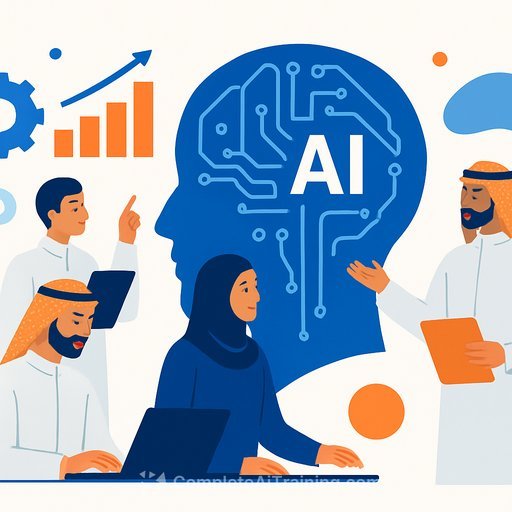Teachers Favor AI-But Only With Real Training
AI is already in students' hands. The question isn't "if," it's "how." A new Samsung-sponsored HarrisX survey of 620 U.S. public middle and high school teachers makes one thing clear: educators see real learning value in AI, but they want guardrails, skills, and time to get it right.
The top fear is predictable and valid-students leaning on AI and letting critical thinking slide. The upside is just as clear-teachers with proper training report better learning outcomes, better access, and more confidence using AI.
At a Glance
- Most teachers lack formal AI training, especially in under-resourced schools.
- Training flips attitudes: trained teachers are far more favorable and confident.
- AI can help close learning gaps through individualized support and accessibility.
What the Survey Says
Readiness and Use
- 88% say AI will be important to students' futures.
- 93% say students already use AI; 76% believe they use it often.
- 61% say students are prepared for an AI-shaped workforce, but only 13% say "very prepared."
- Preparation varies by resources: 72% in well-resourced schools vs. 42% in under-resourced schools.
Top Concern: Critical Thinking
- 81% worry AI could replace critical thinking skills.
- 81% fear students will lean on AI more than their own reasoning.
- 77% say students may stop thinking for themselves.
The Training Gap
- 53% have no formal AI training; 64% in under-resourced schools.
- Only 11% have more than 15 hours of PD.
- 63% say they haven't received the training needed to use AI effectively.
- What teachers want: hands-on workshops (75%) and step-by-step tutorials (73%).
Training Changes Everything
- Favorability: 87% of trained teachers vs. 55% untrained.
- Appropriate in teachers' own work: 87% trained vs. 65% untrained.
- Student preparedness: 76% trained vs. 49% untrained.
- Future jobs: 85% trained vs. 59% untrained.
- Accessibility/inclusivity: 84% trained vs. 60% untrained.
- Enhanced experiences/outcomes: 88% trained vs. 67% untrained.
- Reducing learning gaps via individualized support: 85% trained vs. 63% untrained.
Framing Matters
- 70% say they're more likely to use AI if it's positioned as a tool for social good and community engagement.
What This Means for Your School
If you want the benefits without sacrificing thinking skills, pair AI use with clear structure and targeted PD. Here's a practical plan you can start this term.
Immediate Actions (Next 30-60 Days)
- Set guardrails: draft a classroom AI use policy (allowed uses, citation, plagiarism rules, privacy). Share with students and families.
- Protect critical thinking: require students to show their process-prompts used, drafts, and revisions. Grade reasoning, not just final answers.
- Pick 3 use cases: feedback on writing, language support, and lesson planning. Pilot with a small teacher cohort.
- Equity first: ensure AI support (devices, access, time) reaches students who need it most. Pair AI tools with human tutoring and small-group instruction.
- Assessment fit: include AI-resistant tasks-oral defenses, handwritten work, project logs, and source checks.
- Data and safety: review student data policies; use tools with admin controls and transparent usage logs.
PD That Works (Hands-On, Not Just Theory)
- Workshop 1: AI basics, prompt structure, safety, and bias checkpoints.
- Workshop 2: Lesson planning with AI-standards alignment, formative checks, and differentiation.
- Workshop 3: Accessibility-speech, translation, simplified text, and accommodations.
- Workshop 4: Academic integrity-source tracing, citation, and AI use statements on assignments.
90-Day Rollout (Simple Milestones)
- Weeks 1-2: Policy, tool list, parent communication, teacher survey.
- Weeks 3-4: Two workshops + classroom pilots in ELA and Social Studies.
- Weeks 5-6: Critical-thinking rubrics and AI reflection journals for students.
- Weeks 7-8: Accessibility integrations and multilingual support.
- Week 9: Review pilot data; expand what worked, drop what didn't.
Programs and Funding
Samsung, in partnership with the Mark Cuban Foundation, is offering free AI training resources for educators and support through its Solve for Tomorrow initiative. The program has provided over $29 million in technology and classroom resources in the U.S., reaching 2.9 million youth globally.
Applications are open for this year's competition through the extended deadline of November 24, 2025. Winning schools can receive up to $100,000 in Samsung technology and classroom resources from a $2 million prize pool.
Apply or learn more about Samsung Solve for Tomorrow
Source
Survey conducted online by HarrisX in October 2025 with 620 U.S. public middle and high school teachers.
If Your Staff Needs Training
Given the link between training and better outcomes, consider structured courses that blend policy, pedagogy, and classroom practice. Start with practical, classroom-ready modules and clear implementation templates.
- Complete AI Training: Courses by Job - find educator-relevant options and PD-friendly formats.
Bottom Line
Teachers aren't against AI. They're against unstructured AI. Give them practical training, a policy that protects thinking, and tools that improve access. Do that, and AI supports learning instead of replacing it.
Your membership also unlocks:






